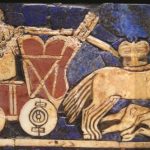 Technology
Technology  Technology
Technology  Humans
Humans 10 Everyday Human Behaviors That Are Actually Survival Instincts
 Animals
Animals 10 Animals That Humiliated and Harmed Historical Leaders
 History
History 10 Most Influential Protests in Modern History
 Creepy
Creepy 10 More Representations of Death from Myth, Legend, and Folktale
 Technology
Technology 10 Scientific Breakthroughs of 2025 That’ll Change Everything
 Our World
Our World 10 Ways Icelandic Culture Makes Other Countries Look Boring
 Misconceptions
Misconceptions 10 Common Misconceptions About the Victorian Era
 Mysteries
Mysteries 10 Strange Unexplained Mysteries of 2025
 Miscellaneous
Miscellaneous 10 of History’s Most Bell-Ringing Finishing Moves
 Technology
Technology Top 10 Everyday Tech Buzzwords That Hide a Darker Past
 Humans
Humans 10 Everyday Human Behaviors That Are Actually Survival Instincts
 Animals
Animals 10 Animals That Humiliated and Harmed Historical Leaders
Who's Behind Listverse?

Jamie Frater
Head Editor
Jamie founded Listverse due to an insatiable desire to share fascinating, obscure, and bizarre facts. He has been a guest speaker on numerous national radio and television stations and is a five time published author.
More About Us History
History 10 Most Influential Protests in Modern History
 Creepy
Creepy 10 More Representations of Death from Myth, Legend, and Folktale
 Technology
Technology 10 Scientific Breakthroughs of 2025 That’ll Change Everything
 Our World
Our World 10 Ways Icelandic Culture Makes Other Countries Look Boring
 Misconceptions
Misconceptions 10 Common Misconceptions About the Victorian Era
 Mysteries
Mysteries 10 Strange Unexplained Mysteries of 2025
 Miscellaneous
Miscellaneous 10 of History’s Most Bell-Ringing Finishing Moves
10 Surprising Duties of the U.S. President
The President of the United States is often seen as a symbol of power and leadership, responsible for commanding the military, signing laws, and shaping national policy. However, the job of the president extends far beyond these high-profile responsibilities. Tucked away in the Constitution, federal statutes, and historical precedents are duties that range from deeply symbolic to surprisingly obscure. While these tasks often involve delegating to teams of experts and advisors, they remain, at their core, the president’s responsibility, underscoring the vast and multifaceted nature of the office.
From approving state flags to overseeing ceremonial traditions, these lesser-known presidential roles reveal how even the smallest tasks contribute to the cultural, political, and symbolic legacy of the presidency. Here are 10 of the most surprising and often-overlooked responsibilities that fall under the president’s purview.
Related: Ten Truths About What Life Is Like for Former U.S. Presidents
10 Serving as Honorary Head of the Boy Scouts of America
Since 1910, every U.S. President has served as the honorary president of the Boy Scouts of America (BSA), a tradition that connects the office to one of the nation’s largest youth organizations. The role involves endorsing scouting values like leadership, community service, and citizenship. Presidents have attended key events, including National Jamborees, and often host award ceremonies for Eagle Scouts at the White House.
For instance, President John F. Kennedy, himself a former Scout, actively supported the organization and praised its role in shaping the character of young Americans. Similarly, President Obama recorded special messages for Scouts during Jamborees. However, the role hasn’t always been without controversy—Presidents have occasionally been drawn into public debates over the BSA’s policies on inclusion, such as decisions regarding LGBTQ+ members and leaders. Despite these challenges, the honorary presidency highlights the office’s enduring influence on civic values.[1]
9 Issuing Metrication Proclamations
While Americans overwhelmingly prefer the imperial system, the president is tasked with encouraging the adoption of the metric system through proclamations. This responsibility stems from the Metric Conversion Act of 1975, which declared metrication the preferred system of measurement for federal agencies and businesses. Though the initiative was never fully realized, the president retains this quirky authority.
Presidents Gerald Ford and Jimmy Carter both issued statements promoting metrication, especially in scientific fields and international trade. However, public resistance to metric road signs in the 1970s stalled broader adoption. More recently, Presidents have focused on encouraging metric use in industries like pharmaceuticals, where it is already the global standard. While rarely emphasized, this duty reflects the government’s ongoing struggle to align with international norms.[2]
8 Managing the White House Beehive
The installation of a beehive on the White House grounds during the Obama administration added a surprising environmental responsibility to the president’s portfolio. While professional staff tend to the hive, its broader purpose—raising awareness about pollinator health—falls under the president’s symbolic stewardship.
The hive produces over 100 pounds (45.4 kg) of honey annually, much of which is used in state dinners, holiday gifts, and as part of environmental education efforts. For example, the honey has been served to world leaders, including at a 2015 state dinner for Chinese President Xi Jinping. First Lady Michelle Obama also used the hive to promote her “Let’s Move!” campaign, highlighting the role of pollinators in sustainable agriculture. The beehive exemplifies how small initiatives can amplify awareness of critical environmental issues.[3]
7 Commanding the Presidential Emergency Satchel (“Nuclear Football”)
The nuclear football, officially called the Presidential Emergency Satchel, is one of the most sobering responsibilities of the presidency. This briefcase contains the tools and authentication codes needed to launch a nuclear strike. It is carried by a military aide who remains within arm’s reach of the president at all times, whether at the White House or traveling abroad.
While the football’s details are classified, it is known to include a secure communication system and a list of pre-approved strike options. During the January 6 Capitol attack, the football’s proximity to Vice President Mike Pence highlighted the high stakes of protecting this device. The satchel is a constant reminder of the president’s ultimate authority over the nation’s defense—and the catastrophic consequences of its misuse.[4]
6 Naming National Monuments
The Antiquities Act of 1906 grants the president sweeping authority to designate national monuments, allowing them to protect significant land, structures, or artifacts without congressional approval. This power has been used to preserve iconic landmarks like the Statue of Liberty (designated by Calvin Coolidge) and the Grand Staircase-Escalante in Utah (designated by Bill Clinton).
Presidents have also used this power to protect culturally significant sites, such as President Obama’s designation of the Stonewall National Monument in New York City, honoring LGBTQ+ rights. Critics argue that this authority sometimes bypasses local input, as seen when President Trump reduced the size of Bears Ears National Monument in Utah. Nevertheless, this unique presidential duty has shaped the nation’s conservation legacy for over a century.[5]
5 Owning a Personal Presidential Seal
Every U.S. president has access to the official Presidential Seal, but they also have the unique right to create a personalized version for private use. The official seal, used on government documents, podiums, and Air Force One, symbolizes the authority and dignity of the presidency. However, customized seals often appear on non-official items such as campaign merchandise, personal gifts, or even recreational gear, blending the personal with the political.
For example, President Trump’s customized seal was prominently displayed on golf apparel sold at his resorts, drawing both attention and criticism for its commercial use. Similarly, President Obama’s personal seal appeared on commemorative basketballs given to visiting dignitaries, reflecting his well-known love for the sport. These personalized seals allow Presidents to leave their own unique mark on the office, offering insight into their personalities and priorities. Over time, they have become subtle yet powerful tools for shaping the public image of the presidency.[6]
4 Approving State Flags and Seals
When a U.S. territory transitions to statehood, the President plays a surprising role in approving its flag and seal. This little-known duty ensures that new states adopt symbols reflecting American values and ideals. For example, President Dwight D. Eisenhower approved Alaska’s state flag in 1959, which was famously designed by 13-year-old Benny Benson. The flag, featuring the Big Dipper and North Star, symbolizes the territory’s natural beauty and aspirations.
This responsibility goes beyond mere approval—it underscores the president’s role in unifying the nation’s identity. In the case of Hawaii, President Eisenhower also oversaw the approval of its iconic flag, which integrates elements of the British Union Jack to honor the islands’ history. These approvals mark pivotal moments in U.S. history as territories become states and fully join the union. Though rare today, this duty reflects the intricate ways the presidency connects to local governance and the nation’s expansion.[7]
3 Delivering an Annual Economic Report
Each year, the president must submit an Economic Report to Congress, a detailed document assessing the state of the economy, forecasting trends, and outlining policy goals. This report is prepared in collaboration with the Council of Economic Advisers and serves as a critical tool for guiding fiscal and economic debates. Though it receives less public attention than the State of the Union, the report directly influences legislative priorities and public understanding of economic challenges.
For example, during the Great Recession in 2009, President Obama’s Economic Report emphasized the urgent need for stimulus measures, tax cuts, and infrastructure investments to stabilize the economy. Similarly, President Biden’s 2022 report highlighted supply chain disruptions and proposed strategies for combating inflation. The report also addresses niche economic sectors, from emerging technologies like green energy to international trade agreements, showcasing the President’s wide-reaching influence over financial policy. While technical in nature, these reports are pivotal in shaping both short- and long-term economic strategies.[8]
2 Controlling the National Christmas Tree
The president’s role in lighting the National Christmas Tree, located on the Ellipse near the White House, is a beloved tradition dating back to 1923. While the event is largely ceremonial, it reflects the President’s broader role as a unifying figure during times of national celebration. The tree-lighting ceremony often includes performances by renowned musicians, holiday readings, and appearances by prominent public figures.
In recent years, the tree has also incorporated modern themes like sustainability, with presidents promoting the use of energy-efficient LED lights or eco-friendly decorations. For instance, President Obama highlighted environmental stewardship during his tenure, while President George W. Bush used the event post-9/11 to honor first responders and military personnel. Beyond its festive atmosphere, the ceremony underscores the presidency’s role in fostering national morale and unity, even through symbolic gestures.[9]
1 Directing the Minting of Commemorative Coins
The president has the authority to approve commemorative coin programs, which honor significant events, individuals, and anniversaries. These coins, minted by the U.S. Treasury, serve dual purposes: celebrating history and raising funds for meaningful causes. For example, President Reagan approved coins commemorating the Statue of Liberty’s centennial, with proceeds helping fund the restoration of the iconic monument.
Presidents also use these coins to highlight cultural and historical milestones. Under President Obama, coins were minted to honor the Civil Rights Movement and the legacy of Dr. Martin Luther King Jr. Additionally, the Apollo 11 commemorative coins issued during President Trump’s term celebrated the 50th anniversary of the moon landing, with a portion of sales supporting space exploration initiatives. These coins serve as tangible reminders of America’s achievements, with the President playing a key role in shaping how the nation remembers its past.[10]








